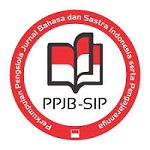KOHESI DAN KOHERENSI DALAM NOVEL KKN DI DESA PENARI KARYA SIMPLEMAN DAN IMPLIKASINYA TERHADAP PEMBELAJARAN BAHASA INDONESIA DI SMA
DOI:
https://doi.org/10.32938/jbi.v5i3.612Keywords:
wacana, kohesi, koherensiAbstract
Cohesion and coherence have an important role in writing essays, both those that will write or those that have become essays. Therefore this study aims to determine the use of cohesion and coherence in the KKN novel in Penari Village. The object of this research is the KKN novel in Penari Village by Simpleman. The subject of this research is the sentence which contains the type of cohesion and coherence in the KKN novel in Penari Village by Simpleman. The approach used is a qualitative approach. A qualitative approach is an approach that presents data in the form of sentences. The design of this research is by collecting data, then the data is grouped according to the use of cohesion and coherence types, then the data is analyzed and presented in an informal form. Data collection techniques using reading techniques and note taking techniques. The technique of presenting the results of the analysis using informal techniques. Informal techniques are techniques that present data in the form of common words that are easily understood by the reader.
The results of this study are grammatical cohesion, lexical cohesion and coherence types. Grammatical cohesion includes: reference, substitution, ellipsis, and conjunction. The use of lexical cohesion are of two types namely, repetition and collocation. The use of coherence there are five relationships, namely: the sum relationship, the sequential relationship, the resistance relationship, the causal relationship, and the time relationship.
Downloads
Published
How to Cite
Issue
Section
License
Penulis yang mengirimkan naskahnya pada Jubindo telah memahami ketentuan yang berlaku pada jurnal ini. Jika naskah tersebut diterbitkan, hak cipta artikel itu akan diserahkan kepada Jubindo dan Universitas Timor sebagai penerbit jurnal tersebut.
Hak cipta ini meliputi hak eksklusif untuk mereproduksi dan menyiarkan artikel dalam berbagai bentuk media. Reproduksi sebagian atau keseluruhan isi jurnal ini dan segala yang melekat padanya haruslah dengan seizin Jubindo dan Universitas Timor.
Jubindo dan Universitas Timor, Dewan Editor, dan Reviewer berusaha menjamin agar tidak terjadi kesalahan atau penyimpangan dalam penyajian data dan pernyataan yang dikutip pada jurnal. Dalam hal naskah yang termuat berisi penghargaan pada pihak-pihak tertentu sebagai donatur atau sponsor, itu merupakan bagian yang terpisah dari Jubindo dan menjadi kepentingan penulis dengan pihak sponsor.
Semua artikel yang dimuat dalam jurnal ini bersifat Open Access dan bebas dibaca, diunduh, dan disebarluaskan oleh para pembaca selama tidak mengabaikan lisensi yang diacu oleh Jubindo: yaitu http://creativecommons.org/licenses/by-sa/4.0









